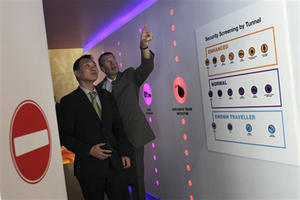Aviation securityAirport Checkpoint of the Future unveiled
Attendees of the 67th annual Air Transport Association (IATA) annual meeting and World Air Transport Summit in Singapore got a first look at a prototype version of the airport security Checkpoint of the Future; the prototype checkpoint is specifically designed to allow passengers to pass through without having to remove their shoes or get patted down; to make travelling more pleasant and less invasive, the new security checkpoint is outfitted with a suite of sophisticated sensors including eye scanners, x-rays, and metal and liquid detectors

Checkpoint of the future scans multiple threats in a non-intrusive manner // Source: pddnet.com
Attendees of the 67th annual Air Transport Association (IATA) annual meeting and World Air Transport Summit in Singapore got a first look at a prototype version of the airport security Checkpoint of the Future.
The model checkpoint was created in response to increasing frustration and privacy concerns with enhanced security procedures at airports and is specifically designed to allow passengers to pass through without having to remove their shoes or get patted down. “We spend $7.4 billion a year to keep aviation secure. But our passengers only see hassle. Passengers should be able to get from curb to boarding gate with dignity,” said Giovanni Bisignani, IATA’s director general and CEO. “That means without stopping, stripping or unpacking, and certainly not groping.”
To make travelling more pleasant and less invasive, the new security checkpoint is outfitted with a suite of sophisticated sensors including eye scanners, x-rays, and metal and liquid detectors.
When passengers arrive at security checkpoints, they will be biometrically identified with iris and fingerprint scans which will then be matched to a biometric passport. Following that, passengers will meet with a behavioral analyst before they are allowed to walk through scanners that will search for any contraband items.
In addition, the Checkpoint of the Future uses a “risk-based approach” that divides travellers into three categories with varying levels of security. Rather than forcing all passengers to go through the same security line, passengers will now go through either “known traveller,” “normal,” or “enhanced security” checkpoints.
Passengers will be pre-screened ahead of time using electronic data by government officials to determine ahead of time which line the passenger must wait in.
Bisignani explained that the new system moves away from simply searching for contraband items to one that focuses on finding “bad people.”
Most travellers will be placed in the “normal” line as they have not completed federal background checks, but have documents and biometric identifiers that do not trigger any alarms. “Known travellers” will have an expedited process as they have already registered with government authorities and have undergone background checks. Finally, the “enhanced security” line is for passengers who are deemed an “elevated risk” by government authorities.
While many of this technology is currently available like metal detectors and behavior analysts, biometric and passenger data screening could take three years to develop and explosives detection could take several years longer.
